
|
January 2013
|
|
|
The U.S. Department of Energy's Thomas Jefferson National Accelerator Facility
|
|
Staff Scientist, M. Shinn Elected to APS Fellowship |
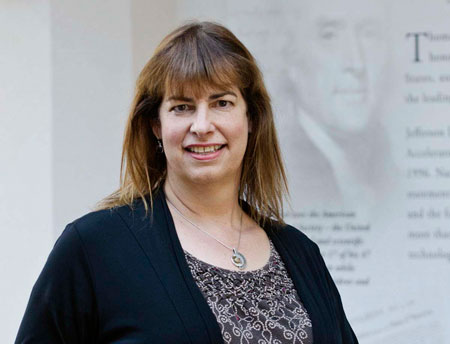 Michelle Shinn, chief optical scientist in the Free-Electron Laser Division, is a newly elected Fellow of the American Physical Society.
To spend time with Michelle Shinn, a senior scientist in the Free-Electron Laser Division and a newly elected Fellow of the American Physical Society, is to step into a conversation in which she seamlessly quotes Thomas Jefferson, Daniel Patrick Moynihan and John Adams, and discourses on the raising of bees, the talks she gives on astronomy and her life-long passion for physics. A self-described "child of 'why?'" Shinn has been questioning the world around her and diving into learning since she was toddler in Oklahoma. She still recalls declining her mother's response of "because" – and insisting on a better one – when she asked why a toy top demonstrated the principle of precession . She realized early on the only way to get the answers she sought was in the world of science. An experiment in an eighth-grade physical science class that demonstrated the movement of a mild electrical current through a group of students holding hands in a circle was one "X" mark on her life map. "What kind of science explains this?"...... more |
|
|
How to Successfully Tackle Those New Year's Resolutions
|
B. Rogers Joins Training Office; Calls Job a 'Perfect' Fit
|
Science Ed. Team Prepares for Summer Intern Programs
|
||
|
|
||||
Below the Fold: |
||||
|
|
||||
Staff Scientist, M. Shinn Elected to APS Fellowship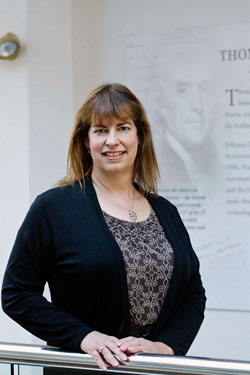 Michelle Shinn, a senior scientist in the Free-Electron Laser Division, was recently elected for fellowship by the American Physical Society's Forum on Industrial and Applied Physics for her contributions in the applications of lasers in society, particularly the development of high-power optics technologies for rare-earth solid state lasers and free-electron lasers
To spend time with Michelle Shinn, a senior scientist in the Free-Electron Laser Division and a newly elected Fellow of the American Physical Society, is to step into a conversation in which she seamlessly quotes Thomas Jefferson, Daniel Patrick Moynihan and John Adams, and discourses on the raising of bees, the talks she gives on astronomy and her life-long passion for physics. A self-described "child of 'why?'" Shinn has been questioning the world around her and diving into learning since she was toddler in Oklahoma. She still recalls declining her mother's response of "because" – and insisting on a better one – when she asked why a toy top demonstrated the principle of precession . She realized early on the only way to get the answers she sought was in the world of science. An experiment in an eighth-grade physical science class that demonstrated the movement of a mild electrical current through a group of students holding hands in a circle was one "X" mark on her life map. "What kind of science explains this?" she wanted to know. The answer, of course, was physics. By her senior year at Oklahoma State University , where she received a bachelor's degree in physics with a minor in math, she was asking: What would she do with that degree? A master's seemed a given, but her adviser pointed out that if she had a Ph.D. she could do research and have a team of her own, an idea that was immensely appealing. "Still, I hedged my bets and did a master's with a thesis," she recalled. Although she looked at bigger schools – Yale, Harvard, the University of North Carolina and the University of Illinois among them – and had lots of offers, the lure of family and a smaller graduate physics program kept her at Oklahoma State. "At a big school, you're a nameless person, and these large programs are hard wash-outs," she noted of her decision. "It's dog eat dog. I decided to stay at Oklahoma State and be a bigger fish in that smaller pond. Maybe that wouldn't be perfect for everyone, but it worked well for me." Her next big decision was pivotal as well. After she received her Ph.D. in physics at Oklahoma State in 1983 under the guidance of William Sibley, with whom she remains close friends, she set out for Lawrence Livermore National Laboratory , where she worked as a physicist on advanced laser drivers for the ICF (Inertial Confinement Fusion) program. "I made a decision to break with tradition," she noted. "It was usual for my peers to get a post-doc for two years, and then enter academia. Since Bill Sibley had come from a national lab, I decided to follow that path." After six years there, she became an associate professor at Bryn Mawr College , where she stayed for more than four years before coming to Jefferson Lab in 1995, working first under Fred Dylla and, now, George Neil. She led the FEL Optics group from its inception until 2007, and is now the chief optical scientist for the division, determining specifications for all high-power optical systems for the FEL. She holds seven patents in optical technology for her work, and was recently honored by the American Physical Society for her contributions in the applications of lasers in society, particularly the development of high-power optics technologies for rare-earth solid state lasers and free-electron lasers. She was nominated for fellowship by the APS Forum on Industrial and Applied Physics. Active APS members are eligible for nomination and election to fellowship, according to information on the APS webpage that reads: "The criterion for election is exceptional contributions to physics; e.g., outstanding physics research, important applications of physics, leadership in or service to physics, or significant contributions to physics education. Fellowship is a distinct honor signifying recognition by one's professional peers." Shinn has authored or co-authored more than 170 publications – most of them during her time at Jefferson Lab. She considers the nearly 90 listed on her curriculum vitae to be the most important. She has served as guest editor of Optical Engineering for a special issue on laser damage and has written two book chapters, one on lasers and laser optics and the other on free-electron laser optics damage mechanisms. Shinn's interests outside work span science, music and art. Spurred by fellow staff scientist Gwyn Williams' interest in raising bees, this year she dove into beekeeping with her characteristic gusto. She now has a hive containing thousands of bees at her home in Newport News. The telescope she received as a gift from her grandparents as a child led to a deep interest in astronomy that was put aside for many years, in deference to her interest in physics. Then in 2005, she woke up one day and asked herself, "What are you going to do today to enjoy life even more?" Astronomy was the answer, and since that time she has become involved in "star parties," where amateur astronomers gather to observe the night sky. Ultimately, she was asked to become a speaker for those groups and she now gives talks on dark matter and energy that merge cosmology and physics. A mother of three grown daughters, Shinn is also an inveterate bird watcher, and is learning to play the guitar. She reads when she has the time and is making her way through biographies of the early U.S. presidents and has started work on a memoir. Her passion is driven by a singular, personal question: "How do I make the world better?" When the letter arrived announcing her selection as a 2012 APS Fellow , one of the highest peer honors a physicist can receive, she at first thought it was a piece of "quasi junk mail" and opened it leisurely. As she glanced over the content, the reality of it nearly overwhelmed her. "This is huge to me," she said. "I couldn't have had this happen, though, without Jefferson Lab. The opportunities that a scientist has here and the team of people I work with are tremendous ... nothing is done in isolation. It's because of the entire team that I've had the opportunities to create what I have." By Judi Tull |
||||
|
|
||||
How to Successfully Tackle Those New Year's Resolutions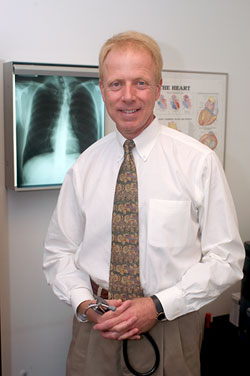 Dr. Walter S. "Smitty" Chandler, Jefferson Lab's Occupational Medicine director, encourages individuals working to make successful lifestyle changes to introduce small changes over time.
Dr. Chandler suggests tactics for making healthy lifestyle changes So you’ve made those New Year's resolutions: You're going to eat better and less, exercise more, and give up those bad habits. Dr. Walter S. "Smitty" Chandler, Jefferson Lab's Occupational Medicine director, has a message for you: Slow down. "The most common cause of failure in positive lifestyle change is trying to go too fast," he said. "People get impassioned, then they get frustrated if they don't see immediate improvement. It takes decades to become a certain way and, therefore, it takes time to make improvements that last." And the power to make those changes is all yours. Smoking, Chandler explained, is the single worst thing you can do when it comes to your health. Its effects are far reaching and its addictive qualities powerful, in part because inhaling is the second fastest method of drug delivery to the body. That makes smoking extremely "reinforcing." The key to quitting, he said, is to keep at it, and maintain a fighting attitude. "The people who ultimately fail at smoking cessation are the ones who, having tried once or twice to quit and were unsuccessful, give up and take the attitude of 'I'll take my chances,'" he said. "The ones who succeed are those who keep trying over and over until they succeed." Regarding nutrition, Chandler suggested that, overall, sugar and sweets are the most unhealthful foods, followed by starches and fat from red meat. He also recommends against snacking between meals. "In theory, snacking is consistent with our heritage because most of our genetic makeup comes to us from populations that grazed on things like berries and insects. But in today's world, it is the norm to 'graze' on snacks that are high in sugar and fat." Cut out the snacking and you’ll do yourself a world of good. Getting up from the table sooner is a good first step toward healthy weight loss. "Many people need more structure in their diet," Dr. Chandler said. "At meals, eat until you’re full, but not stuffed. Slow down and give your body the chance to tell you it is full." In the long run, he pointed out, overeating - and eating sweets and starches - leads to more hunger and, in a vicious cycle, more overeating. "In the long run, eating more causes more hunger. Eating less causes less hunger." Like smoking, being overweight can have far-reaching consequences. Overweight people tend to exercise less; and they are more vulnerable to developing numerous diseases such as heart attack, cancer and adult-onset diabetes. Longevity, the doctor said, is influenced by waist size. "But don't try to change too much too fast," he advised, "because, in the long run you will fail. Make one small improvement per month every month. Each improvement makes the next a little easier. These improvements add up. You will feel better and live longer. If improvement is torture, you're going too fast. Go, but go slow. Make the journey a reward, not a punishment." So, start small. Spend a year declaring war on sweets. At the end of it, you won't even like sweets anymore. Spend the next year minimizing starches (white bread, white rice, white potatoes and white pasta). Next reduce animal fats, and so on. The more improvements you make, the more you can make and the more you'll want to make." The single most critical key to well being, Chandler added, is exercise. He participates in - and recommends for others - exercise that burns a minimum of 2,000 calories a week. That equates to walking or running approximately 20 miles a week, or doing some other vigorous activity. (Actually, the details of caloric expenditure during various forms of exercise and in people of varying weight are more complex than that, but this is a useful estimate.) "Regular exercise is our best mechanism for improved health," he noted. "Many of the phenomena that we attribute to aging are actually only weakly associated with the passage of time, per se. Instead, they are more strongly associated with steadily reduced physical activity over the years. Regular exercise buffers us from the reduced quality of life that comes with 'age.' Regular exercise decreases intellectual decline, cardiovascular death and disability, cancer, and much more." "Some experts estimate that you live two minutes longer for every minute you exercise. It also makes people more productive and energetic." "It isn't always easy to find time to exercise. But, here again, evolution beats revolution. It takes time to adjust your habit system to incorporate exercise. For instance, you have to decide what to give up in order to have more time for exercise," he said, "and TV is the right place to start." One reason that exercise can help in weight control is that exercise raises your metabolism so that eventually, even when you're not in motion, your internal motor is running at a faster speed. One thing you don't want to give up in order to exercise, however, is sleep, another key component to an overall healthy lifestyle. You owe your brain seven to eight hours of sleep a night and you should do everything possible to get it, Chandler emphasized. Give up that late-night TV program and hit the sack. If you're waking out of a deep sleep to the screech of the alarm clock, you're not getting the sleep you need. Chronic sleep deprivation can lead to a variety of health problems, including cardiovascular disease. It also reduces alertness, a key element needed, especially at the lab, for safety and productivity. The essential element of successful lifestyle change is to think of each small step as laying down the base of a pyramid of health. As you make each small change for the better, you'll feel better. And soon you'll feel better about doing good things for yourself instead of hanging on to those old, bad habits. And that, Chandler said, is the key to keeping at it. "Evolution beats revolution. You're not sentencing yourself to a life of deprivation," he said. "People with healthful lifestyles have lots of fun." The lab's Occupational Medicine staff offers on-going wellness support including individualized counseling and advice with Chandler, and blood pressure and cholesterol monitoring. The Occ. Med. team encourages the Jefferson Lab community to get started on preventing disease before it begins. |
||||
|
|
||||
B. Rogers Joins Training Office; Calls Job a 'Perfect' Fit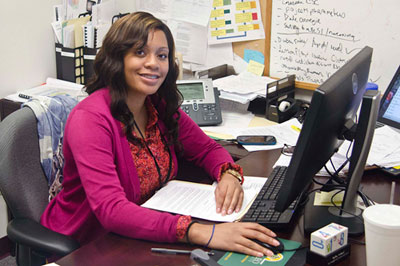 Brandye Rogers, Training and Performance consultant, is also a member of Jefferson Lab's Diversity and Inclusion Council, which was formed in 2012.
Jefferson Lab Training and Performance consultant Brandye Rogers covered a lot of territory before she was a senior in high school, and she was energized by every moment of it. It was that same adventuresome spirit that lured her to Jefferson Lab, first in a temporary capacity, and now as a full-time staff member. Born in San Francisco to military parents – her dad a public affairs officer, her mom a nurse – the family moved to Germany, where they spent four years. While she was a toddler, the family moved to Izmir, Turkey. After four years there, it was on to the Netherlands for eight years. They ended up in Hampton, where she graduated from Bethel High School. Throughout high school, Rogers had ambitions to become an attorney and obtained her bachelor's (2007) and master's (2011) degrees in criminal justice from St. Leo University. Only later did she discover a career path that became her passion: Human resources. At Alcoa Howmet in Hampton, Rogers cut her HR teeth setting up meetings, helping with recruiting and staffing, giving employee orientation sessions, working on training logistics, and assisting with employee development and relations programs. In 2010, she took an HR position with Catalina Cylinders. There, she provided support for the department and served as the first point of contact for client inquiries and services issues, as well as designing and distributing the company's monthly newsletter. During her time at Catalina Cylinders, Rogers spotted an announcement for a temporary position as executive assistant to Jefferson Lab's Human Resources manager, Rhonda Barbosa. Temporary staffing was needed while the full-time executive assistant, Josh Cameron, headed out to complete officer training for the Army Reserves. Rogers' time was shared between HR and the chief financial officer, Joe Scarcello. She came on board in October 2011 and immediately found a welcoming environment. "It was definitely a different environment for me – in terms of the science being done here. But I found it very comfortable," she commented. "I'd spent most of my career dealing with people, and it was relatively easy to acclimate into the lab's culture. And since I'd lived and traveled abroad, I was also accustomed to interacting with people of various backgrounds." During her eight-month temporary assignment, Rogers provided direct administrative support for HR and the CFO, managed several lab-wide programs and databases, and supported special projects in recruiting and diversity. She also started learning more about web-based training from Bruce Ullman, the Lab's Training and Performance manager. When a position in the Training and Performance office became available, Rogers immediately applied. She started her new job in May. "It was a perfect fit," she noted. "I was able to come into the position knowing HR and being familiar with the training software." Now Rogers spends her time troubleshooting and updating content material for web-based training, working with subject matter experts on developing safety courses, and managing the training database. She also conducts orientation sessions for new hires, maintains the database for education reimbursements and job-related training, and leads classes on the lab's performance appraisal system for managers and employees. "Everyone here has been so helpful and giving of their time," she said as she reflected on the past 15 months. "Bruce has been wonderful, and he's still mentoring me. It's been an awesome ride and I look forward to the opportunities that the future holds." One of the assignments she's most passionate about is sitting on Jefferson Lab's new 17-member Diversity and Inclusion (D&I) Council, with its charter to lead the lab's efforts to promote a diverse workforce and ensure everyone feels valued for his or her contributions. The D&I initiative is focused on awareness, not compliance, and is based on the assumption that Jefferson Lab people support the goals of diversity and inclusion, but may not realize that unconscious (or "implicit") bias can still be a problem, according to Rogers. "Implicit bias is a very real issue and we hope to raise awareness about it," she explained. "After council members complete their specially designed curriculum, we will be able to pass on our knowledge within our respective divisions and groups." The council started work in October 2012 and will meet quarterly. It is co-chaired by Mary Logue, associate director of the ESH&Q Division, and Rolf Ent, associate director of the Experimental Nuclear Physics Division. One of the things the council hopes to do periodically is host guest speakers for special talks – much like last year's presentation on the status of women in science and engineering by Elizabeth Simmons, a noted theoretical physicist and dean of Lyman Briggs College at Michigan State University. An accomplished public speaker in her own right, Rogers is already working on a second master's degree; this one at Old Dominion University in instructional design. |
||||
|
|
||||
Science Ed. Team Prepares for Summer Intern Programs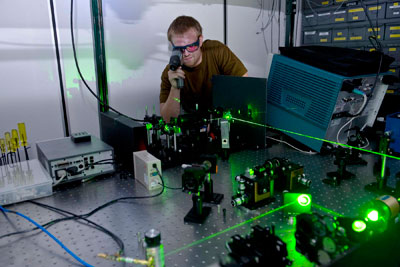 A summer intern works on a laser system at Jefferson Lab. Projects and mentors are critical to the success of the lab's summer internship programs. The research or project work can be for one student or for small groups of students.
The Winter is upon us, but the Science Education team at Jefferson Lab is already well into planning and preparing for the lab's 2013 summer science internship programs. Two of the programs conducted at the lab each summer are specifically designed for college undergraduates interested in finding out about or pursuing careers in STEM fields (science, technology, engineering and math). The Science Undergraduate Laboratory Internships (SULI) program is designed to provide undergraduates with valuable educational experiences that allow them to participate in mission-related research at Department of Energy facilities. The program is supported by the DOE's Office of Science, Office of Workforce Development for Teachers and Scientists. Applications for the summer 2013 session were due by Jan. 10. The Research Experience for Undergraduates (REU) program also conducted at the lab is a partnership between Old Dominion University and Jefferson Lab, and is funded by a National Science Foundation grant. The REU program offers students direct access to laboratory equipment, facilities and staff through research experiences that aren't generally available on college campuses. The deadline for REU applications is Feb. 15. Both programs seek students who are majoring in physics, science, engineering, computer science, and mathematics. The programs start and run together for 10 intense weeks. The 2013 programs will start on May 28 and run through Aug. 2. They give participants valuable educational, interpersonal and job-skills experiences by doing "real time" work in a laboratory setting, according to Lisa Surles-Law, JLab's summer undergrad programs manager. "The programs immerse students in a scientific environment in hopes of encouraging them to pursue a career in a scientific or other high-tech field," explains Surles-Law. "Also, by exposing them to a research environment we hope that many of them will return to this environment at some point in their careers. "These programs provide outstanding academic, and professional and interpersonal development experiences for students," she notes. "The students come to us from very diverse backgrounds and have different skill levels," she adds. "We provide individualized or one-on-one guidance when it is needed, and help the students discover what motivates them." Feedback from the interns has been very positive over the years, according to Surles-Law. "Nearly everyone has responded that the internship experience was very meaningful. We really enjoy seeing the students' progress over the course of the program. Many of them make noticeable advancements – academically, professionally and on an interpersonal level. It is thrilling to see a student go into a new environment and start absorbing it. They start to understand how they can produce something of value and how their efforts can make an impact," she continues. "They learn to handle responsibility and take their commitments very seriously." New to the programs' agenda in 2012 was a "Roads to Success" discussion between the students and a panel of lab staff. The panel included a senior lab manager, a former intern, and representatives from a couple of the major divisions. Panel members shared their professional and personal experiences, and provided perspective and insight on their respective fields and career challenges. "This addition proved to be very popular with the students and was very well received," Surles-Law says. Highlights of the annual program include a lunch session with Lab Director Hugh Montgomery, and later in the program, a poster session attended by hundreds from the lab community, which marks the end of the program. "The students really enjoy their time with our lab director," Surles-Law says. "He engages and challenges the students, and really connects with them." The interns are required to develop a poster based on the work or research they conducted over the summer. "The interns must develop their posters and prepare so they can present and discuss their research and answer questions. They are expected to dress and present themselves professionally," she explains. "It is a rare opportunity for the students to do this – especially within a scientific community. The poster session is well worth the time and effort; it provides the students with a great experience and good material for a first CV. And, it gives them a finished product (the poster) that can be used for other events later in the academic year." The REU students also make oral presentations of their research projects to the faculty and students of the Physics Department at Old Dominion University. The SULI program is available to undergraduates at 15 of the DOE national labs. Jefferson Lab conducts the program over the summer, but many of the larger labs also offer spring and fall sessions. Students may participate in two SULI internships – both can be at the same lab or at different labs. Through the schools or programs they have been enrolled in, over the years several interns have gone on to doctoral programs and even postdoc positions affiliated with Jefferson Lab. Information about these and the summer, high school honors internship program at Jefferson Lab is available at: http://education.jlab.org/indexpages/index.html |
||||
|
|
||||
Below the Fold: |
||||
Science Education Seeks Projects, Mentors for InternsCritical to the success of Jefferson Lab's summer internship programs are projects for the students, and mentors who can oversee one or more students as they carry out their work. "The students are bright, hard working, motivated young people who are looking for challenges," says Lisa Surles-Law, JLab's summer undergrad programs manager. "They tend to be team players who want to be part of something bigger than themselves, and are eager for the opportunity to work and learn about careers in scientific fields." "Over the years, many of our mentors have been pleasantly surprised by the level of work the students are capable of," Surles-Law adds. She urges supervisors and project managers to look over their work plans for the summer. "During the Long Shutdown there are many areas and types of work that the interns could be involved in. Think about your needs," she asks. "Do you have a project or work opportunity that a student or group of students could be involved in? "It doesn't need to be a big project or involve a large research effort," Surles-Law points out. The work could be for one student or could involve multiple students. Science Education staff provides the interns with a lab orientation and all the basic safety training before the interns are sent out to their respective work areas and assignments. Science Education staff also provides the students with programmatic structure and support, so the mentors can focus on providing project information or work oversight as needed. Staff members, who are interested in mentoring a student or students, are asked to send a brief description of their research, project or work idea to Jan Tyler, Science Education manager, at: tyler@jlab.org . Ideas should be sent to Tyler by mid-February for consideration in the summer 2013 program. Anyone with questions or who would like additional information about mentoring or developing a project or work idea may contact Tyler or Surles-Law at: surles@jlab.org Result from Research Conducted at JLab Reported in DOE Pulse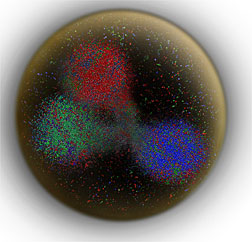 Researchers have found intriguing new evidence on how the different kinds of quarks behave inside protons and neutrons. In the proton, one of the up quarks and the only down quark appear to combine into a diquark, while the remaining up quark hangs out on its own. Measurements with higher precision are planned to test the idea
It's often been said that two's company, but three's a crowd. Now, scientists have found that old saw may be true for the smallest bits of matter: quarks. Nearly everything in our visible universe is built of quarks. Quarks are the smallest, indivisible particles of matter that bind together in threes to build protons and neutrons. Protons and neutrons form the nuclei that reside at the center of every atom of every molecule of every thing around us. Now, researchers have found intriguing new evidence, from data gathered from experiments conducted at Jefferson Lab, on how the different kinds of quarks behave inside protons and neutrons. The data and insights, which were published in the journal Physical Review Letters , have recently received further support and scrutiny from theory. This result was featured in a recent issue of the DOE Pulse. Read the complete article, titled " Quarks Pair Up in Protons (and Neutrons) " accessible online from DOE Pulse Issue 376 at: http://www.ornl.gov/info/news/pulse/no376/ . DOE Pulse is a twice-monthly online publication that highlights scientific and research advancements from across the U.S. Department of Energy national labs. The PRL result, titled "Flavor Decomposition of the Elastic Nucleon Electromagnetic Form Factors" is posted at: http://prl.aps.org/abstract/PRL/v106/i25/e252003 . Volunteers Sought to Help With Middle School Science Bowl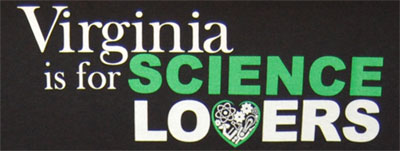 Pictured here is the 2013 Virginia Regional Science Bowl T-shirt design. All team contestants and their coaches and volunteers receive a T-shirt. The winning teams will wear their T-shirts to the national competition to be held in Washington, D.C. in April.
The 2013 National Science Bowl season is here. Jefferson Lab's Science Education team and more than 50 volunteers are ready for the Virginia Regional High School Science Bowl set for Saturday, Feb. 2. However, volunteers are still needed for the to help with the Middle School Science Bowl scheduled for Saturday, March 2. The National Science Bowl competition, sponsored annually by the U.S. Department of Energy since 1991, is a highly visible series of academic competitions among teams of students. "These events champion an interest in science, math and technology," says Jan Tyler, Science Education manager. "They are a great way to promote academic excellence and to raise awareness about STEM (science, technology, engineering and math) careers." Volunteer support is essential to the success of both events, according to Tyler. "We couldn't put these tournaments on without our volunteers." More than 50 volunteers are needed to run each of the events. While nearly every volunteer opening for the Feb. 2 event has been filled, a number of openings are available for the March 2 competition. Most of the volunteers perform as competition moderators, rules judges, timekeepers and scorekeepers during the morning, round-robin sessions, according to Tyler. A smaller number of volunteers are needed to run the afternoon double-elimination matches, be the on-site scientific judge who is called when a student challenges a question or answer during the competition and a few individuals to help with administrative tasks and the afternoon Stay All Day Contest held in the Support Service Center (Building 28) classrooms. "We need new and experienced volunteers. If you have volunteered for prior Science Bowls, or if you've never been to a Science Bowl, but want to be part of the excitement, we want you," she says. "These events are great fun. We provide all volunteers with training and a practice session, a Science Bowl T-shirt, and lunch if you work morning and afternoon. We need you, your co-workers, spouse and children (over age 13) to assist with the many activities required to conduct these academic competitions." Most of the public areas and conference rooms of CEBAF Center will be taken over during each of the competition days. Twenty-three teams are registered to compete in the High School Science Bowl; and nearly 20 schools are expected to take part in the middle school tournament. The top three teams of each event will earn cash prizes for their respective schools. The top high school and middle school teams will also win expenses-paid trips to the DOE Science Bowl Nationals April 25-29 in Washington, D.C. Each team is made up of four or five students, and a teacher who serves as advisor and coach. A Science Bowl is an academic competition among teams of students who compete in a verbal forum to solve technical problems and answer questions in all branches of science and math. The regional and national events encourage student involvement and interest in math and science activities, improve awareness of career options in science and technology, and provide an avenue of enrichment and reward for academic science achievement, according to Tyler. Teams that don't advance to the afternoon finals rounds are invited to stay for the day and compete in a series of design and engineering challenges dubbed the Stay All Day Contest. Teams are presented with different activities or challenges where they have to analyze problems, develop working prototypes with specific materials and make projections based on a model's performance. The team with the best combined results for the activities wins. Helping with the Science Bowls is strictly a volunteer activity, Tyler reminds aspiring helpers. Anyone interested in more information or in volunteering, may contact her by email at: tyler@jlab.org . Volunteers may sign up for one or both events; the morning shift runs from 8:30 a.m. to 1 p.m., the entire day lasts from 8:30 a.m. to around 3 p.m. Check out the information and video clips on the following links for more information about the science bowl competition and the duties of volunteers: - http://www.youtube.com/watch?v=4vbkunWhWFM The afternoon semi-finals and final rounds held in the CEBAF Center auditorium will be open to the public. High School Science Bowl Practice Session Feb. 1 (Friday) at 9:30 a.m. in CEBAF Center, Bldg. 12, Room F113 Come and go between 9:30 and 10:30 a.m. as best suits your schedule and needs. Milestones for November - December 2012Hello Jason Glorioso, Hall A Electro/Mechanical Tech, Experimental Nuclear Physics Division Goodbye Josephat Biron, Accelerator Operations and R&D Division These Milestone entries, listed alphabetically, are full-time, term, casual and student actions posted by Human Resources for November through December 2012. Jefferson Lab is currently seeking qualified individuals for nearly a dozen positions, including scientific, engineering, technical, administration and intern positions. All current employment opportunities are posted at: [Link Removed] = Information about career opportunities at Jefferson Lab is available at: [Link Removed] Donate Books and Conference Proceedings to the JLab LibraryAs you do spring cleaning – tidying up office and work spaces around Jefferson Lab – please consider donating non-fiction books and conference proceedings you don't want to keep, to the library, instead of throwing them out. Library staff suggests that instead of throwing away print books, journals or collections, they can be donated to the Jefferson Lab library. Staff will evaluate and digitize what is needed and discard the rest. While User space at the lab is being cleaned up over the next couple months, collection boxes have been set out. Boxes are labeled "Book Donations for the Library," and are located in: Donations placed in the boxes will be picked up at least weekly. These drop-off locations are only for books being donated. Books or materials checked out from the library must be returned to the library book drop. Fiction books no longer wanted may be placed on the "share a book" shelf outside of Room L107 in CEBAF Center. For more information or if you have a large amount of material to donate, please contact Sandra DSouza at the library, ext. 7524 |
||||
|
The On Target newsletter is published monthly by the Thomas Jefferson National Accelerator Facility (Jefferson Lab), a nuclear physics research laboratory in Newport News, Virginia, operated by Jefferson Science Associates, LLC , for the U.S. Department of Energy's Office of Science . Possible news items and ideas for future stories may be emailed to jlabinfo@jlab.org , or sent to the Jefferson Lab Public Affairs Office , Suite 15, 12000 Jefferson Avenue, Newport News, VA 23606
|
||||


 Dr. Chandler suggests tactics for making healthy lifestyle changes. So you’ve made those New Year's resolutions....
Dr. Chandler suggests tactics for making healthy lifestyle changes. So you’ve made those New Year's resolutions....  Jefferson Lab Training and Performance consultant Brandye Rogers covered a lot of territory before she was a senior in high school, and she was energized by every moment of it......
Jefferson Lab Training and Performance consultant Brandye Rogers covered a lot of territory before she was a senior in high school, and she was energized by every moment of it......  The Winter is upon us, but the Science Education team at Jefferson Lab is already well into planning and preparing for the lab's 2013 summer science internship programs....
The Winter is upon us, but the Science Education team at Jefferson Lab is already well into planning and preparing for the lab's 2013 summer science internship programs....